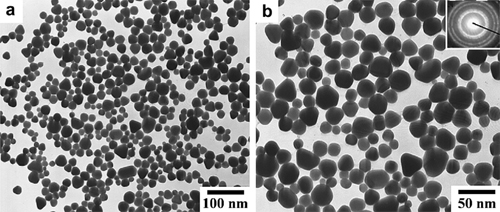
TEM and SAED images of colloidal Ag nanoparticles: (a) colloidal Ag nanoparticles (b) SAED pattern of Ag nanoparticles.
Researchers of the State Key Laboratory for Oxo Synthesis and Selective Oxidation of the Lanzhou Institute of Chemical Physics (LICP) of the CAS have developed a new route for hydrogen generation from biomass at room temperature without any carbon monoxide over nano-metal-catalysts.
It has been found that the Ag nanocrystals are highly efficient and stable catalysts for the CO-free hydrogen production from formaldehyde (HCHO), a model compound of biomass, at room temperature and at atmospheric pressure. By optimizing the structure and component of catalysts, reaction parameters such as temperature, catalyst amounts, oxygen, formaldehyde concentrations, and NaOH concentrations, the hydrogen generation rate has been maintained for hours without any decay. Furthermore, the apparent activation energy of the Ag catalyzed hydrogen production reaction is determined to be 11.8 kJmol-1, which was much lower than that of the literature results (65 kJ mol-1) without catalyst.
Because of its high hydrogen generation rate, hydrogen generation efficiency, lower activation energy, and the low cost, this novel Ag catalyst based hydrogen generation reaction may be a promising candidate for providing hydrogen in PEMFCs at room temperature.
Proton exchange membrane fuel cell (PEMFC) has attracted great attention as green power sources because of its important attributes. However, the success of the application of such PEMFCs depends largely on the hydrogen supply. Unfortunately, most present hydrogen production methods cannot satisfy the rigorous criteria of PEMFCs such as size, cost, safety, and purity, especially for a mobile PEMFC. To address these problems, much effort has been focused on developing novel CO-free hydrogen generation methods at low temperature for PEMFCs, while limited progress has been made to date.
The work has received support from the National Program on Key Basic Research Project of China and National High-tech R&D Program of China and Solar Energy Project of Chinese Academy of Sciences.
The detailed report of the work has been published in International Journal of Hydrogen Energy (International Journal of Hydrogen Energy 35(2010)7177-7182).
International Journal of Hydrogen Energy Paper
